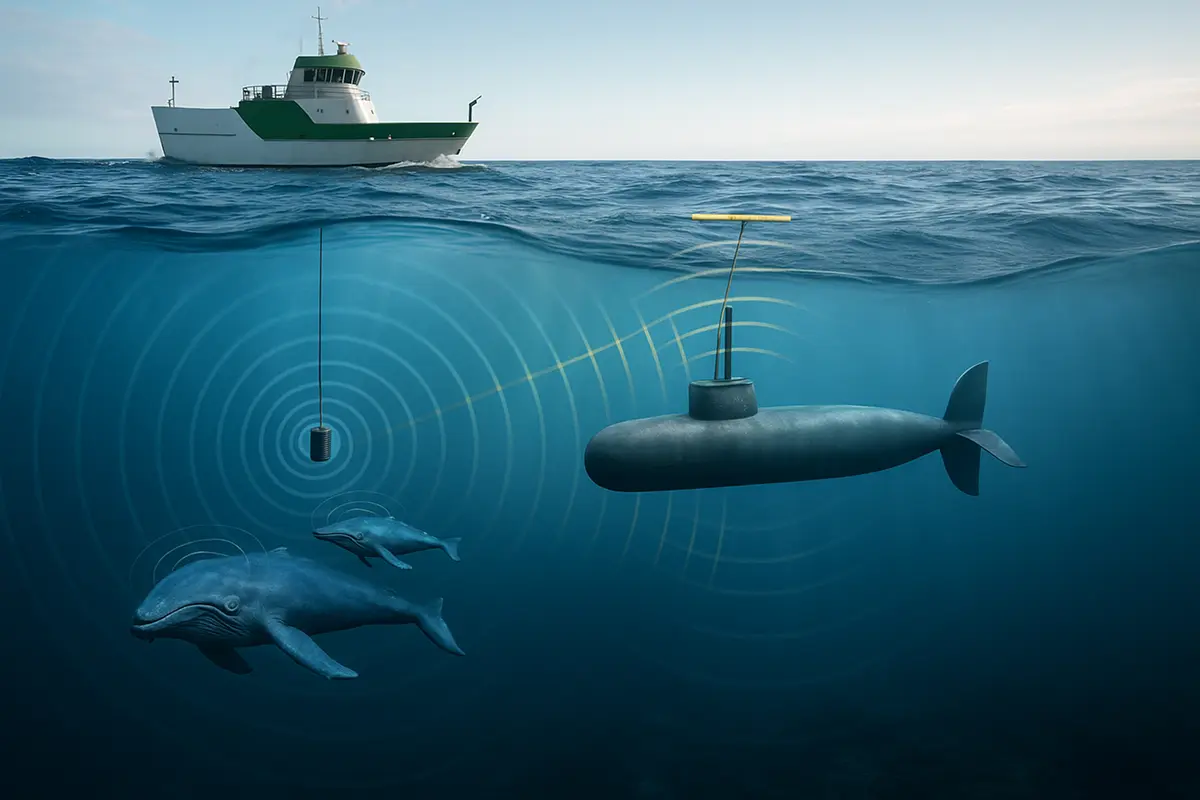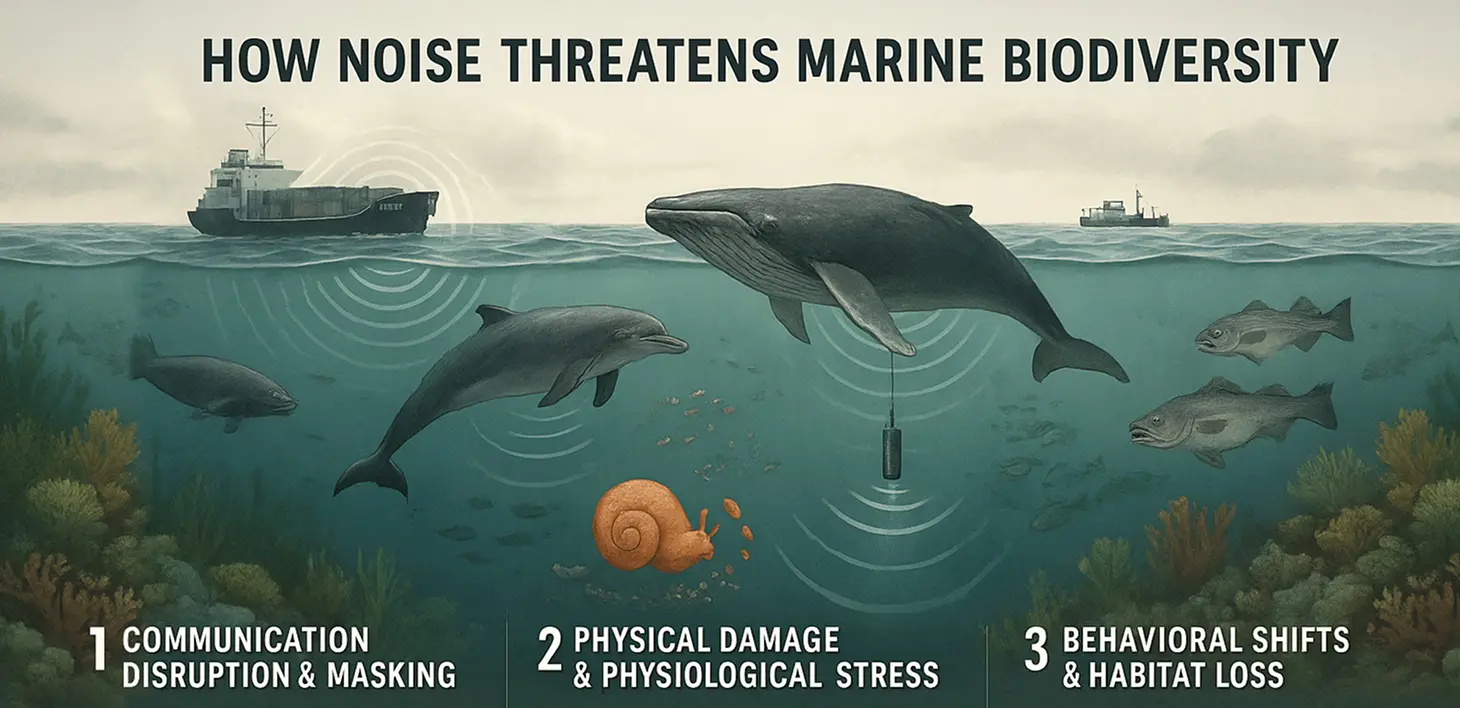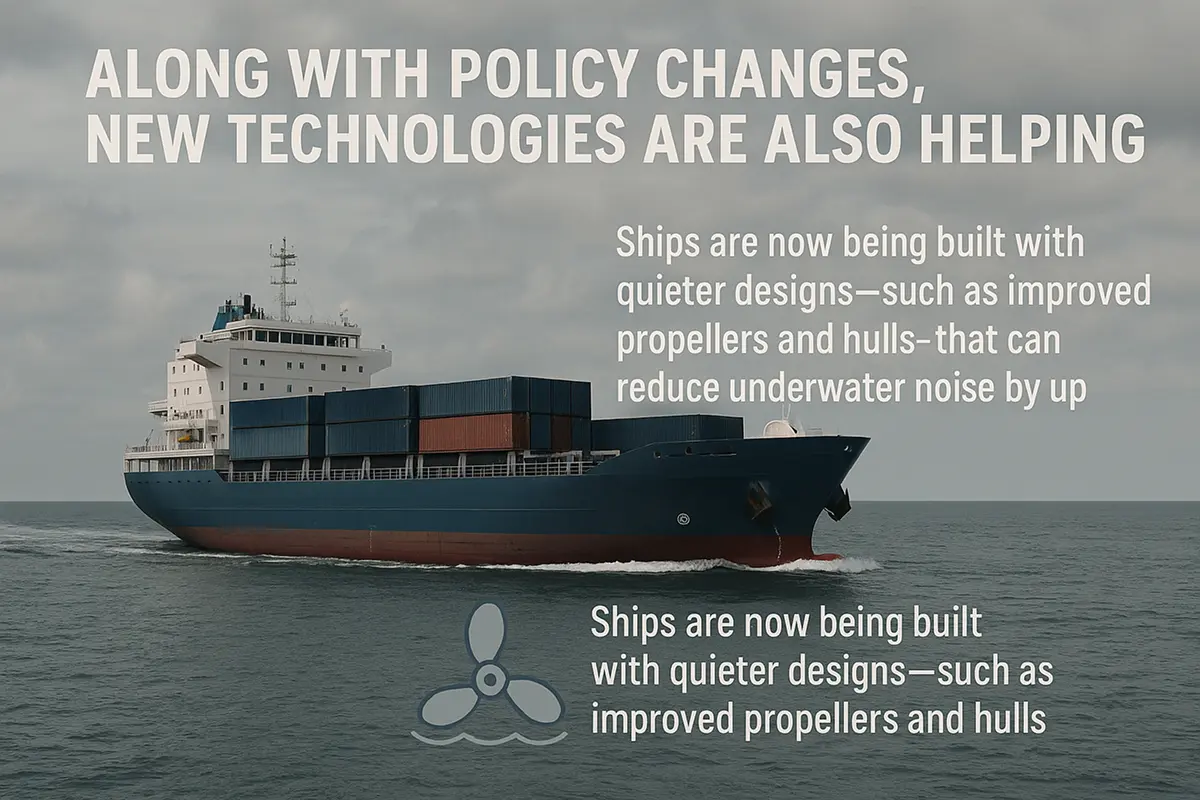The ocean was once a quiet and peaceful place, filled with natural sounds. But now, it’s filled with constant noise from human activities. In the last 50 years, ocean noise has increased a lot—up to 32 times more in some areas. This is mainly because of more ships, oil drilling, military sonar, and construction in the water. This noise isn’t just annoying—it’s a serious problem for ocean life by causing noise pollution in ocean.
Marine animals depend on sound, just like land animals depend on sight. Whales, dolphins, fish, and even tiny plankton use sound to talk to each other, find their way, avoid danger, search for food, and reproduce. But when loud human-made noises fill the ocean, it messes up these important activities. This can stress the animals, confuse them, or even hurt and kill them.
A 2021 study published in Science found that during the COVID-19 lockdowns, ocean noise dropped by 20%. With fewer ships and less industrial work, scientists saw that marine animals started coming back to places they had left. They also showed fewer signs of stress. This proved how much humans affect the ocean—and how quickly nature can recover when things quiet down.
Even though we can’t see it, noise pollution in the ocean is now seen by scientists as a major threat—just like plastic waste, climate change, and ocean acidification. But most people don’t know about it, and global rules to stop it are still not strong enough.
What is Noise Pollution in Ocean and Why Does It Matters?
At its core, ocean noise pollution caused by human-made sounds that disturb the ocean’s natural sound environment. Big cargo ships create deep, low-frequency rumbling sounds that can travel hundreds of kilometers. Military sonar systems send out loud, powerful sound waves that go deep into the ocean. Seismic surveys used to find oil and gas create repeated loud blasts, and construction in the ocean—like building wind farms or bridges—adds even more noise.

Unlike pollution we can see, this noise pollution is invisible and hard to measure. But its effects on ocean life and ecosystems are very real and widespread. According to research by Oceans-Research, there are still no global rules or agreements that limit how much underwater noise human activities can create.
How Human Activity Amplified Ocean Noise Pollution Over Decades?
Studies show that ocean noise has gone up very quickly since the mid-1900s. In busy shipping areas, noise levels have doubled about every 10 years. For example, on the west coast of the U.S., ocean noise has increased by around 10 decibels since the 1960s. This rise in noise has real effects on marine life.
Loud sounds from seismic airguns, used to search for oil and gas, can damage the organs of zooplankton—tiny creatures that are a key part of the ocean food chain. Fish larvae, which usually follow sounds to find coral reefs, often get lost in noisy areas and don’t survive. In lab studies, sea hare embryos exposed to boat noise developed 21% more slowly and had a 22% higher death rate. Large sea animals like whales showed higher levels of cortisol, a hormone linked to stress, when exposed to shipping noise over 190 decibels.
Their behaviour also changes in harmful ways. Fish like cod and haddock stay away from noisy areas, which makes it harder for them to spawn and reproduce. Beaked whales have even found stranded in groups after hearing loud military sonar. Young reef fish struggle to find their way and settle on coral reefs, which harms the health and biodiversity of ocean ecosystems in the long run.
From Whales to Plankton: How This Pollution Disrupts Marine Species?
The impacts of ocean noise extend beyond individual species. When key organisms are driven away or suffer population declines, it disrupts entire ecosystems. These disruptions can create trophic cascades—chain reactions that destabilize food webs. Displaced invertebrates like oysters and crabs further weaken ecological stability. In acoustic hotspots such as coral reefs, biodiversity loss threatens the health and resilience of entire habitats.

How Noise Threatens Marine Biodiversity?
1. Communication Disruption & Masking
- Whales and dolphins rely on echolocation and calls. Ship and sonar noise can cause them to shout louder yet communicate less effectively.
- Beaked whales, which depend on precise acoustic navigation, have been known to strand en masse due to naval sonar exposure.
2. Physical Damage & Physiological Stress
- Fish mortality rises when larvae fail to find reefs due to masked reef sounds.
- Studies link seismic airgun noise to organ damage in zooplankton—vital to the marine food web .
- Embryos of sea hares show 21% slower development; larval mortality climbs by 22% under boat-noise playback—highlighting the peril noise poses to even the tiniest marine organisms.
3. Behavioral Shifts & Habitat Loss
- Affected fish species, such as cod and haddock, reduce spawning and avoid noisy zones.
- Coral reef fish larvae fail to navigate to reefs, affecting ecosystem regeneration.
- Displaced species lead to acoustic refuges, shrinking habitats vital for biological communities.
Solutions to Tackle This Pollution: Global Action and Innovations
In 2025, a big international step was taken to fight ocean noise pollution. At the United Nations Ocean Conference, 37 countries—including Canada and Panama—launched the High Ambition Coalition for a Quiet Ocean. This is one of the most organized global efforts to deal with underwater noise. The goal is to treat ocean soundscapes (natural ocean sounds) as an important part of protecting marine life.

Along with policy changes, new technologies are also helping. Ships are now being built with quieter designs—such as improved propellers and hulls. This can reduce underwater noise by up to 20 decibels. In 2024, smart algorithms developed to help ships move more efficiently while making less noise. During construction work in the ocean, “bubble curtains” are used. These are walls of air bubbles that surround the work area and reduce noise by up to 90%. Also, when building offshore wind farms, planners are now working to reduce low-frequency noise, which is especially important as the demand for renewable energy increases.
Another important effort is the International Quiet Ocean Experiment (IQOE), which started in 2015. It tracks underwater noise levels around the world. The data helps scientists and decision-makers find the noisiest areas and plan ways to reduce the impact of sound on marine life.
Policies, Public Awareness, and the Push to Reduce Ocean Pollution
Governments are starting to take action. The European Union now requires noise impact checks for offshore projects. Ports like Vancouver give financial rewards to ships that meet quiet sound standards. Even the military is changing how it uses sonar to reduce harm to whales and dolphins.
But government rules alone are not enough. Public support, corporate action, and investment in quieter technology are all important. Awareness campaigns, pressure from environmental groups, and shared funding for research can help speed up change.
Reversing the Impact of Ocean Noise Pollution
Ocean noise is one of the most ignored threats to sea life—but it’s also one of the easiest to fix. Studies show that marine animals quickly return and recover when the ocean gets quieter. So, improvement is very possible.
As human activities in the ocean—like shipping, energy projects, and deep-sea exploration—continue to grow, we must also reduce the noise we create. This means supporting marine protected areas, following sustainable development rules, pushing for stronger laws, and investing in low-noise technologies.
Science is clear: Quieter oceans mean healthier marine life and a better future for our oceans.